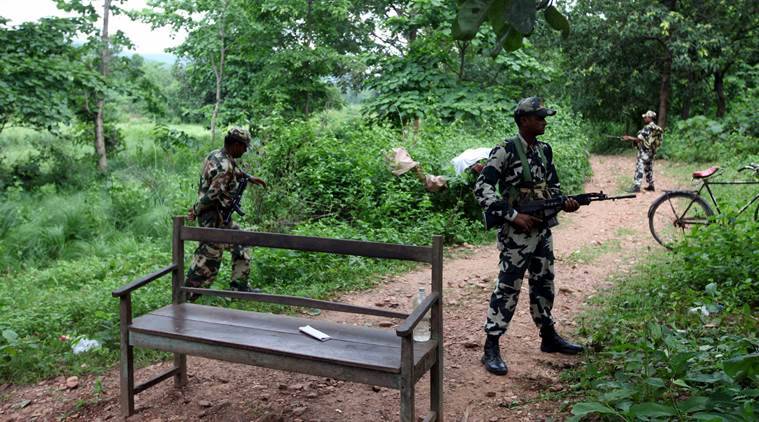
THE MAOIST brass are worried about the qualitative fall in their ranks and their organisation’s vulnerability to “information based attacks”, and foresee no change in government policy irrespective of who wins the 2019 Lok Sabha elections, according to “rare” documents seized late last year from a camp run by the CPI (Maoist) in Dantewada.
The documents, believed to be of the CPI (Maoist)’s Central Committee (CC), its top decision-making body, and its Central Military Commission (CMC), also reveal that the cadre has gained “experiences” in activities such as making “improvised artillery” using indigenous materials and sniping.
Security sources told The Sunday Express that these “self-assessment” documents are important because of their length — the CC “sandesh” has 18 pages and the CMC document 32. They also include military roadmaps, they said.
When contacted, Chhattisgarh DGP D M Awasthi confirmed the authenticity of the documents. “All the literature we have been able to get has been checked and is a valuable source of information. These documents of the CC and the CMC are highly confidential documents, which show their current state, their morale, and the way they intend to move forward.”
Awasthi described the documents as “rare” because “these are not compiled that often”. The documents are dated as being written in July and August 2018, after a change of guard in the top leadership of the CPI (Maoist) when Namballa Keshav Rao, also known as Basavraj, took over as general secretary from Ganapathy. Basavraj has been the CMC chief for several years. “Since he is both CMC chief and CC head now, this shows his direction. We suspect that under his command, militarisation will only increase,” Awasthi said.
The “sandesh” to cadre, dated August 17, 2018, states:
“The enemy is many times stronger than us. They are in the stage of strategic offence and we are at the stage of strategic defence… In the last four years, after many efforts there has been an increase in recruits, but despite this all in all, the extent of our overall power has decreased. The quality of our forces have decreased. The new cadres are not being able to handle the immediate circumstances. Their experiences and awareness is low.” However, it also notes: “In 2013, according to a direction by our Central Committee… in some areas Leadership Training Programmes (LTP) and Military Leadership Training Programmes (MLTP) are giving good experience and leadership qualities.”
On the Lok Sabha elections, the message in Hindi states that the BJP “may be successful and if they come to power, “SAMADHAN” will continue”. On the other hand, it says, “If the Congress is successful in making a Mahagathbandhan, then too that government will work towards the extinguishing of revolutionary movements, and there will be no big difference in policy.” Among the counter-measures it advocates is convincing people to back Kashmiri, Naga, Manipuri, Assamese separatism and other autonomy movements, and support the fight for separate states of Bodoland and Gorkhaland.
The 32-page military “circular”, dated July 25, 2018, details methods to be used against state and central forces. For instance, it states: “The opponent uses four stages in their policy against us. These are Clear, Hold, Build and Develop… In most of our struggle areas in the country, we are in the second or third phase… and in 30 districts where we have the most influence, primarily operations are being held to clear and hold, and based on any success, build operations are being carried out. Where the party was temporarily backed away, develop initiatives are being carried out…”
These papers state: “With attacks from before, and in the last one year the “Samadhan” programme, it is true that we have lost some important powers. In this, some comrades were killed, and some were weakened and surrendered. In some revolutionary areas there has been weakening… It is also true that along with “carpet security”, the enemy has been successful in creating means of travel, communication and information networks.”
This assessment primarily attributes any weakening to a strengthening of state intelligence networks. “By spending vast amounts of money, they are improving their human and technical intelligence. They are trying to make informers bring us civil and military supplies and creating coverts, and are using modern technology to listen to our communications. They are watching those activities that have to be carried out by mobile phones, and are collecting information when our mobiles, tablets and laptops come into their hands…,” it states.
The document appears to cite Dantewada as an example of the government reaching out to tribals through efforts such as Tribal Enterpreneurs Summit in Dantewada in 2017, e-business, e-rickshaws, indigenous businesses, schemes, and cooperative farming models. “… They are putting these people forward as examples of tribal development,” it states.
It also claims that over the years, strategies have been developed on IED drill, ambush, raids, fire and movement, unarmed combat, a military manual, company drills, booby traps, snipers, mine warfare and setting up camps. It declares that “useful lessons have been learnt” from “negative engagements”.